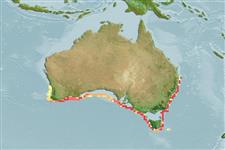分類 / Names
共通名の | 類義語 | Catalog of Fishes(部類, 種) | ITIS | CoL | WoRMS | Cloffa
板鰓亜鋼(サメとエイ類) (sharks and rays) >
Squaliformes (Sleeper and dogfish sharks) >
Centrophoridae (Gulper sharks)
Etymology: Centrophorus: centr[um] (L.), prickle or sharp point; phorus, from phoreus (Gr.), bearer or carrier, referring to grooved spines on dorsal fins (See ETYFish); harrissoni: In honor of biologist Charles Turnbull Harrisson (1869-1914), responsible for collecting and preserving many of the “more interesting” fishes during the “fishing experiments” of FIS Endeavour off the coast of Australia, 1909-1914 [he disappeared along with his ship and all hands in December 1914; no distress message had been given and no trace of the ship has been found] (See ETYFish).
Eponymy: Charles Turnbull Harrisson (1866*–1914) was a biologist from Tasmania who took part in the Mawson Antarctic Expedition (1911–1914) and was responsible for collecting many interesting fish species. [...] (Ref. 128868), visit book page.
Environment: milieu / climate zone / depth range / distribution range
生態学
海 深海魚; 深さの範囲 250 - 790 m (Ref. 6871). Temperate; 26°S - 45°S, 111°E - 155°E
Eastern Indian Ocean: Western Australia. Southwest Pacific: New South Wales to Tasmania. Recorded in Norfolk Ridge, Three Kings Ridge amd Kermadec Ridge, extending the species eastern range (Ref. 89942). Record from Taiwan uncertain. This species is very close to Centrophorus uyato and may be a junior synonym of that species (Ref. 247).
Length at first maturity / サイズ / 重さ / 年齢
Maturity: Lm 99.0 range ? - ? cm
Max length : 111 cm TL オス/雌雄の選別がない; (Ref. 76933)
A moderate-sized species distinguished by the following set of adult characters: length of pre-second dorsal 61.9-63.2% TL, 6.6-8.4 times the dorsal-caudal space; length of pre-first dorsal 30.4-32.0% TL; interdorsal space 18.2-20.6% TL, 2.2-2.6 times dorsal-caudal space; dorsal-caudal space 7.5-9.4% TL, 3.2-4.0 in pectoral-pelvic space; long and robust head, its length 22.4-24.6% TL, 2.7-3.0 times mouth width, its width 13.2-14.0% TL, 4.5-4.8 in pre-second dorsal length; width at anterior of nostrils 7.7-7.9% TL; long snout, its preoral length 11.4-12.4% TL, 2.0-2.2 times head height at anterior of mouth, 1.3-1.5 times mouth width, the horizontal preorbital length 7.1-8.2% TL, the horizontal prenarial length 4.4-5.4% TL; large mouth, its width 7.8-8.5% TL; moderately large pectoral fin, its anterior margin 11.9-12.4% TL, 2.3-2.4 times base length; large caudal fin, the dorsal caudal margin 19.1-19.5% TL; 2.1-2.5 times dorsal-caudal space; moderately large and tall first dorsal fin, its height 6.2-7.0% TL, with moderately robust spine, the base width 0.9-1.0% TL. The dorsal fins of juveniles have a distinct blackish oblique blotch anteriorly and a white blotch on the upper posterior margin; in adults a less distinct dark blotch, often apparent in fresh specimens and with a white blotch restricted to a narrow white posterior margin (occasionally indistinct in largest specimens). Adults with flank denticles flat, block-like, not overlapping, and crenulate. Females and immature males with upper teeth that are strongly oblique, similar in shape, but much smaller than lower teeth; in mature males upper teeth are erect, upright, becoming only slightly oblique laterally. 37-39/30 or 31 (n=3) tooth row count; 117-126 (mean 121.6, n=20) total vertebral centra; 53-59 (56.4, n=21) monospondylous precaudal centra; 29-37 (32.7, n=21) diplospondylous precaudal centra; 85-94 (89.1, n=21) precaudal centra (Ref. 76933).
Found on the continental slope (Ref. 6871, 75154).
Presumably ovoviviparous (Ref. 6871). Smallest mature male
recorded at 82.5 cm TL (Ref. 76933). Longevity assumed to be
high similar to close relative C. zeehaani with
estimated longevity exceeding 46 yrs (Ref. 107026).
Life cycle and mating behavior
成熟 | 繁殖 | 放精 | 卵 | 生産力 | 幼生
Ovoviviparous, embryos feed solely on yolk (Ref. 50449). Distinct pairing with embrace (Ref. 205).
Compagno, L.J.V., 1984. FAO Species Catalogue. Vol. 4. Sharks of the world. An annotated and illustrated catalogue of shark species known to date. Part 1 - Hexanchiformes to Lamniformes. FAO Fish. Synop. 125(4/1):1-249. Rome, FAO. (Ref. 247)
IUCNのレッドリストの状況は (Ref. 130435: Version 2024-1)
絶滅危惧 (EN) (A2bd); Date assessed: 21 November 2019
Human uses
水産業: 興味がない
用具
特記事項
XMLをダウンロードして下さい
インターネットの情報源
Estimates based on models
Preferred temperature (Ref.
123201): 9.5 - 13.3, mean 10.4 °C (based on 22 cells).
Phylogenetic diversity index (Ref.
82804): PD
50 = 0.5001 [Uniqueness, from 0.5 = low to 2.0 = high].
Bayesian length-weight: a=0.00389 (0.00180 - 0.00842), b=3.12 (2.94 - 3.30), in cm total length, based on all LWR estimates for this body shape (Ref.
93245).
栄養段階 (Ref.
69278): 4.3 ±0.3 se; based on size and trophs of closest relatives
回復力 (Ref.
120179): 低い, 4.5年~14年の倍増期間の最小個体群 (Fec assumed to be <100).
Fishing Vulnerability (Ref.
59153): High to very high vulnerability (67 of 100).
Nutrients (Ref.
124155): Calcium = 6.99 [1.35, 36.31] mg/100g; Iron = 0.217 [0.055, 0.667] mg/100g; Protein = 20.1 [17.7, 22.4] %; Omega3 = 0.463 [0.170, 1.408] g/100g; Selenium = 15.9 [4.6, 55.0] μg/100g; VitaminA = 22.4 [4.7, 111.5] μg/100g; Zinc = 0.444 [0.206, 0.839] mg/100g (wet weight);
